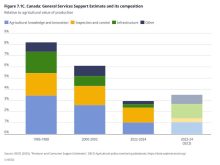Every business is an economic equation balancing input costs with output prices, expenses and revenues to achieve the all-important profit margin number.
For many businesses, the price of those inputs and outputs are relatively stable. In farming, where outputs are volatile agricultural commodities and inputs are made from equally volatile energy, mineral and metal commodities, managing both sides of the equation can be challenging.
Fertilizer is one of the largest farm expenses, often around 25 per cent of revenues. So, when thinking about fertilizer purchases, you can also think about grain marketing to capture a profitable margin between the two.
Read Also

Still hard to predict precise fertilizer payback
Despite decades of advances, international research finds no clear answer for where and when adding nutrient will fail to boost growth.
Historically, fertilizer prices and grain prices tend to move together. The correlation or connection between the two is very high, around 90 per cent. This is not surprising given they are on either side of the same farm economic equation.
But it’s not just the outright prices of fertilizer or grains. What really counts is the direction of the difference or spread between the two.

The price difference between fertilizer inputs and crop outputs has been relatively stable over the past 20 years. As seen on the chart, the spread is usually from about even money to times when fertilizer reaches about US$100 per tonne more than crop values.
There have been two notable exceptions when fertilizer prices spiked to extremely wide levels over crop prices. The first was in 2008, near the end of the commodity investment bull market, when grain prices doubled but fertilizer quadrupled in value.
Shortly thereafter, as the world descended into the mortgage and financial collapse, the ratio of fertilizer to grain prices came back into line and more or less normalized, until last year.
This time around, the mini commodity boom in agriculture was caused by the 2021 drought and then the Russian invasion of Ukraine. Grain prices doubled and fertilizer quadrupled once again. As of mid-September, the extreme pricing of fertilizer compared to grain prices has settled down a bit but the spread is still well above the typical high end of the range seen in the past 20 years.

Will fertilizer ratchet down to the level of grain prices or will grain prices rebound to balance things out? Fertilizer prices have been drifting lower since June but so have grain prices. The previous 2008 scenario is just one data point, so it doesn’t mean the spread will follow the same path.
When it comes to fertilizer production and supply, Russia is a wildcard. It is a major producer of potash, phosphate and nitrogen fertilizers, producing 13 per cent of the global total. In particular, the country accounts for 23 per cent of the global ammonia export market, 14 per cent of urea, 21 per cent of potash and 10 per cent of processed phosphates.
North America imports approximately 20 per cent of its urea from Russia, but Brazil gets about 47 per cent of its potash, 20 per cent of urea and 30 per cent of monoammonium phosphate fertilizer from Russia. I’ve read some estimates that say 90 per cent of the potash used by Ukrainian farmers comes from Russia and Belarus.
Another wild card is the natural gas feedstock for fertilizer and those supplies are heavily influenced by Russia. It accounts for two-thirds of Germany’s natural gas imports, providing 50 per cent of the natural gas supply to Germany and 40 per cent to all of Europe. This natural gas is delivered by two pipelines through Belarus and Ukraine.
In the past two years, European natural gas futures have increased 30-fold and U.S. natural gas futures have tripled during that time. The effect is that some fertilizer companies are cutting production of ammonia in Europe because of high gas costs.
Bottom line, it’s not just whether grain prices go up or down, or fertilizer prices go up or down. It’s the spread between them that’s also important.
So, as you make fertilizer purchases for next year, think of new crop marketing as well. Since we’re still harvesting this year’s grain and are far away from next year’s crop, and face weather risk and price fluctuations, no one wants to commit much grain for delivery.
This is where option strategies can help fill in the marketing gap. They give the needed downside revenue protection with the upside potential desired, without having to promise any production.















